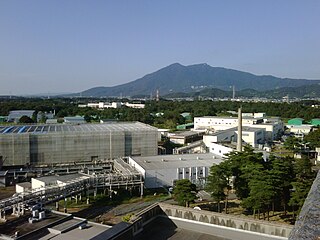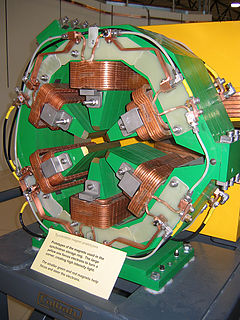Related Research Articles

Fermi National Accelerator Laboratory (Fermilab), located just outside Batavia, Illinois, near Chicago, is a United States Department of Energy national laboratory specializing in high-energy particle physics. Since 2007, Fermilab has been operated by the Fermi Research Alliance, a joint venture of the University of Chicago, and the Universities Research Association (URA). Fermilab is a part of the Illinois Technology and Research Corridor.

A klystron is a specialized linear-beam vacuum tube, invented in 1937 by American electrical engineers Russell and Sigurd Varian, which is used as an amplifier for high radio frequencies, from UHF up into the microwave range. Low-power klystrons are used as oscillators in terrestrial microwave relay communications links, while high-power klystrons are used as output tubes in UHF television transmitters, satellite communication, radar transmitters, and to generate the drive power for modern particle accelerators.

A linear particle accelerator is a type of particle accelerator that accelerates charged subatomic particles or ions to a high speed by subjecting them to a series of oscillating electric potentials along a linear beamline. The principles for such machines were proposed by Gustav Ising in 1924, while the first machine that worked was constructed by Rolf Widerøe in 1928 at the RWTH Aachen University. Linacs have many applications: they generate X-rays and high energy electrons for medicinal purposes in radiation therapy, serve as particle injectors for higher-energy accelerators, and are used directly to achieve the highest kinetic energy for light particles for particle physics.

A synchrotron is a particular type of cyclic particle accelerator, descended from the cyclotron, in which the accelerating particle beam travels around a fixed closed-loop path. The magnetic field which bends the particle beam into its closed path increases with time during the accelerating process, being synchronized to the increasing kinetic energy of the particles. The synchrotron is one of the first accelerator concepts to enable the construction of large-scale facilities, since bending, beam focusing and acceleration can be separated into different components. The most powerful modern particle accelerators use versions of the synchrotron design. The largest synchrotron-type accelerator, also the largest particle accelerator in the world, is the 27-kilometre-circumference (17 mi) Large Hadron Collider (LHC) near Geneva, Switzerland, built in 2008 by the European Organization for Nuclear Research (CERN). It can accelerate beams of protons to an energy of 6.5 teraelectronvolts (TeV).
A charged particle beam is a spatially localized group of electrically charged particles that have approximately the same position, kinetic energy, and direction. The kinetic energies of the particles are much larger than the energies of particles at ambient temperature. The high energy and directionality of charged particle beams make them useful for applications.

The High Energy Accelerator Research Organization, known as KEK, is a Japanese organization whose purpose is to operate the largest particle physics laboratory in Japan, situated in Tsukuba, Ibaraki prefecture. It was established in 1997. The term "KEK" is also used to refer to the laboratory itself, which employs approximately 695 employees. KEK's main function is to provide the particle accelerators and other infrastructure needed for high-energy physics, material science, structural biology, radiation science, computing science, nuclear transmutation and so on. Numerous experiments have been constructed at KEK by the internal and international collaborations that have made use of them. Makoto Kobayashi, emeritus professor at KEK, is known globally for his work on CP-violation, and was awarded the 2008 Nobel Prize in Physics.
A particle beam is a stream of charged or neutral particles, in many cases moving at near the speed of light.
Plasma acceleration is a technique for accelerating charged particles, such as electrons, positrons, and ions, using the electric field associated with electron plasma wave or other high-gradient plasma structures. The plasma acceleration structures are created either using ultra-short laser pulses or energetic particle beams that are matched to the plasma parameters. These techniques offer a way to build high performance particle accelerators of much smaller size than conventional devices. The basic concepts of plasma acceleration and its possibilities were originally conceived by Toshiki Tajima and Prof. John M. Dawson of UCLA in 1979. The initial experimental designs for a "wakefield" accelerator were conceived at UCLA by Prof. Chan Joshi et al. Current experimental devices show accelerating gradients several orders of magnitude better than current particle accelerators over very short distances, and about one order of magnitude better at the one meter scale.

The Spallation Neutron Source (SNS) is an accelerator-based neutron source facility in the U.S. that provides the most intense pulsed neutron beams in the world for scientific research and industrial development. Each year, this facility hosts hundreds of researchers from universities, national laboratories, and industry, who conduct basic and applied research and technology development using neutrons. SNS is part of Oak Ridge National Laboratory, which is managed by UT-Battelle for the United States Department of Energy (DOE). SNS is a DOE Office of Science user facility, and it is open to scientists and researchers from all over the world.
A particle-beam weapon uses a high-energy beam of atomic or subatomic particles to damage the target by disrupting its atomic and/or molecular structure. A particle-beam weapon is a type of directed-energy weapon, which directs energy in a particular and focused direction using particles with minuscule mass. Some particle-beam weapons have potential practical applications, e.g. as an antiballistic missile defense system for the United States and its cancelled Strategic Defense Initiative. They have been known by myriad names: phasers, disruptors, particle accelerator guns, ion cannons, proton beams, lightning rays, rayguns, etc.

The AWAKE facility at CERN is a proof-of-principle experiment, which investigates wakefield plasma acceleration using a proton bunch as a driver, a world-wide first. It aims to accelerate a low-energy witness bunch of electrons from 15-20 MeV to several GeV over a short distance (10m) by creating a high acceleration gradient of several GV/m. Particle accelerators currently in use, like CERN's LHC, use standard or superconductive RF-cavities for acceleration, but they are limited to an acceleration gradient in the order of 100 MV/m.

The Proton Synchrotron (PS) is a particle accelerator at CERN. It is CERN's first synchrotron, beginning its operation in 1959. For a brief period the PS was the world's highest energy particle accelerator. It has since served as a pre-accelerator for the Intersecting Storage Rings (ISR) and the Super Proton Synchrotron (SPS), and is currently part of the Large Hadron Collider (LHC) accelerator complex. In addition to protons, PS has accelerated alpha particles, oxygen and sulphur nuclei, electrons, positrons and antiprotons.

The Christofilos Effect refers to the entrapment of charged particles along magnetic lines of force that was first predicted in 1957 by Nicholas Christofilos. Christofilos suggested the effect had defensive potential in a nuclear war, with so many beta particles (electrons) becoming trapped that warheads flying through the region would see electrical currents so great that their trigger electronics would be damaged. The concept that a few friendly warheads could disrupt an enemy attack was so promising that a series of new nuclear tests was rushed into the schedule before a testing moratorium came into effect in late 1958. These tests demonstrated that the effect was not nearly as strong as predicted, and not enough to damage a warhead. However, the effect is strong enough to be used to black out radars and disable satellites.

The Mainz Microtron, abbreviated MAMI, is a microtron which provides a continuous wave, high intensity, polarized electron beam with an energy up to 1.6 GeV. MAMI is the core of an experimental facility for particle, nuclear and X-ray radiation physics at the Johannes Gutenberg University in Mainz (Germany). It is one of the largest campus-based accelerator facilities for basic research in Europe. The experiments at MAMI are performed by about 200 physicists of many countries organized in international collaborations.

In accelerator physics strong focusing or alternating-gradient focusing is the principle that the net effect on a particle beam of charged particles passing through alternating field gradients is to make the beam converge. By contrast, weak focusing is the principle that nearby circles, described by charged particles moving in a uniform magnetic field, only intersect once per revolution.

A particle accelerator is a machine that uses electromagnetic fields to propel charged particles to very high speeds and energies, and to contain them in well-defined beams.

A storage ring is a type of circular particle accelerator in which a continuous or pulsed particle beam may be kept circulating typically for many hours. Storage of a particular particle depends upon the mass, momentum and usually the charge of the particle to be stored. Storage rings most commonly store electrons, positrons, or protons.
A Fixed-Field alternating gradient Accelerator (FFA) is a circular particle accelerator concept on which development was started in the early 50s, and that can be characterized by its time-independent magnetic fields and the use of strong focusing. Thus, FFA accelerators combine the cyclotron's advantage of continuous, unpulsed operation, with the synchrotron's relatively inexpensive small magnet ring, of narrow bore.

A Dielectric Wall Accelerator (DWA) is a compact linear particle accelerator concept designed and patented in the late 1990s, that works by inducing a travelling electromagnetic wave in a tube which is constructed mostly from dielectric material. The main conceptual difference to a conventional disk-loaded linac system is given by the additional dielectric wall and the coupler construction.
The Astron is a type of fusion power device pioneered by Nicholas Christofilos and built at the Lawrence Livermore National Laboratory during the 1960s and 70s. Astron used a unique confinement system that avoided several of the problems found in contemporary designs like the stellarator and magnetic mirror. Development was greatly slowed by a series of changes to the design that were made with limited oversight, leading to a review committee being set up to oversee further development. The Astron was unable to meet the performance goals set for it by the committee; funding was cancelled in 1972 and development wound down in 1973. Work on similar designs appears to have demonstrated a theoretical problem in the very design that suggests it could never be used for practical generation.
References
- ↑ Humphries, Stanley (1986). "Linear Induction Accelerators". Principles of Charged Particle Acceleration. Wiley-Interscience. pp. 283–325. ISBN 978-0471878780.
- ↑ Christofilos, N.C.; et al. (1963). "High-current linear induction accelerator for electrons". Proceedings, 4th International Conference on High-Energy Accelerators (HEACC63) (PDF). pp. 1482–1488.
| This particle physics–related article is a stub. You can help Wikipedia by expanding it. |